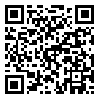Volume 14, Issue 5 (Dec & Jan 2021)
payavard 2021, 14(5): 443-453 |
Back to browse issues page
Ethics code: IR.TUMS.SPH.REC.1398.157
Download citation:
BibTeX | RIS | EndNote | Medlars | ProCite | Reference Manager | RefWorks
Send citation to:



BibTeX | RIS | EndNote | Medlars | ProCite | Reference Manager | RefWorks
Send citation to:
Ghazi Saeedi M, Esmaeili Javid G R, Mohammadzadeh N, Asadallah Khan vali H. Determining the Minimum Data Set of Diabetic Foot Ulcer Patients' Electronic Medical Records. payavard 2021; 14 (5) :443-453
URL: http://payavard.tums.ac.ir/article-1-6922-en.html
URL: http://payavard.tums.ac.ir/article-1-6922-en.html
Marjan Ghazi Saeedi1 
 , Gholam Reza Esmaeili Javid2
, Gholam Reza Esmaeili Javid2 
 , Niloufar Mohammadzadeh3
, Niloufar Mohammadzadeh3 
 , Hamide Asadallah Khan vali *
, Hamide Asadallah Khan vali * 
 4
4

 , Gholam Reza Esmaeili Javid2
, Gholam Reza Esmaeili Javid2 
 , Niloufar Mohammadzadeh3
, Niloufar Mohammadzadeh3 
 , Hamide Asadallah Khan vali *
, Hamide Asadallah Khan vali * 
 4
4
1- Associate Professor, Department of Health Information Management, School of Allied Medical Sciences, Tehran University of Medical Sciences, Tehran, Iran
2- Assistant Professor, Medical Laser Research Center, Academic Center for Education, Culture and Research, Tehran, Iran
3- Assistant Professor, Department of Health Information Management, School of Allied Medical Sciences, Tehran University of Medical Sciences, Tehran, Iran
4- Master of Sciences Student in Health Information Technology, School of Allied Medical Sciences, Tehran University of Medical Sciences, Tehran, Iran ,hamide.vali@yahoo.com
2- Assistant Professor, Medical Laser Research Center, Academic Center for Education, Culture and Research, Tehran, Iran
3- Assistant Professor, Department of Health Information Management, School of Allied Medical Sciences, Tehran University of Medical Sciences, Tehran, Iran
4- Master of Sciences Student in Health Information Technology, School of Allied Medical Sciences, Tehran University of Medical Sciences, Tehran, Iran ,
Abstract: (2216 Views)
Background and Aim: Diabetes is one of the most common metabolic diseases in the world, of which one of the most common and painful complications is diabetic foot ulcer. The accuracy and comprehensiveness of the contents of electronic medical record is effective in improving the quality of treatment and the care of diabetic foot ulcer patients. The aim of this study is to determine the minimum data set (MDS) essential for diabetic foot patients' electronic medical records.
Materials and Methods: In this descriptive-analytical study, authoritative internet and library resources were studied to collect diabetic foot ulcer information elements. Fourteen physicians and nurses working and collaborating with the Wound Healing Center affiliated to Academic Center for Education, Culture and Research (ACECR) were selected for clinical survey, and 5 health information technology specialists of Tehran University of Medical Sciences (TUMS) were chosen for demographic information survey. The study tools were a researcher-made questionnaire, CVR content validity method and test-retest method for reliability.
Results: Out of 23 information elements surveyed in demographic section, cases above 99% of the agreement were selected. Also, out of 86 information elements of the clinical section, more than 51% of the cases were selected. Clinical experts included 6 wound specialists, 4 general practitioners and 6 nurses. In the demographic information section, the lowest agreement was related to the element of identity and Education level with 20% agreement. In clinical information, the lowest agreement was related to surgery, leech therapy and MRI of the foot with 0% and PRP, G-CSF, Sono-Doppler liver with 14%.
Conclusion: The minimum information elements of diabetic foot ulcer electronic medical record were divided into history, wound information, lower limb information, paraclinical results, wound management, and follow-up in clinical section; and in demographic information section, they were divided into identity, admission, finance, reporting, and system capability. The proposed model for manual and electronic medical records is available.
Materials and Methods: In this descriptive-analytical study, authoritative internet and library resources were studied to collect diabetic foot ulcer information elements. Fourteen physicians and nurses working and collaborating with the Wound Healing Center affiliated to Academic Center for Education, Culture and Research (ACECR) were selected for clinical survey, and 5 health information technology specialists of Tehran University of Medical Sciences (TUMS) were chosen for demographic information survey. The study tools were a researcher-made questionnaire, CVR content validity method and test-retest method for reliability.
Results: Out of 23 information elements surveyed in demographic section, cases above 99% of the agreement were selected. Also, out of 86 information elements of the clinical section, more than 51% of the cases were selected. Clinical experts included 6 wound specialists, 4 general practitioners and 6 nurses. In the demographic information section, the lowest agreement was related to the element of identity and Education level with 20% agreement. In clinical information, the lowest agreement was related to surgery, leech therapy and MRI of the foot with 0% and PRP, G-CSF, Sono-Doppler liver with 14%.
Conclusion: The minimum information elements of diabetic foot ulcer electronic medical record were divided into history, wound information, lower limb information, paraclinical results, wound management, and follow-up in clinical section; and in demographic information section, they were divided into identity, admission, finance, reporting, and system capability. The proposed model for manual and electronic medical records is available.
Send email to the article author
| Rights and permissions | |
 |
This work is licensed under a Creative Commons Attribution-NonCommercial 4.0 International License. |



